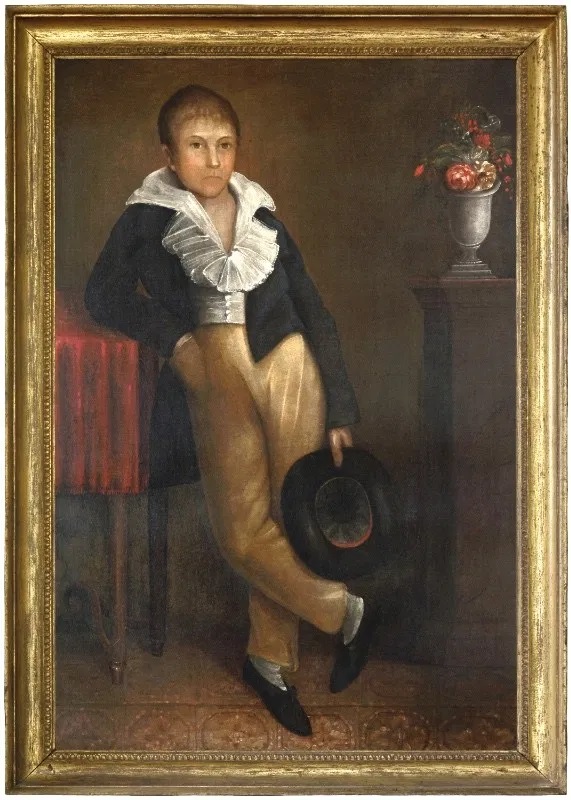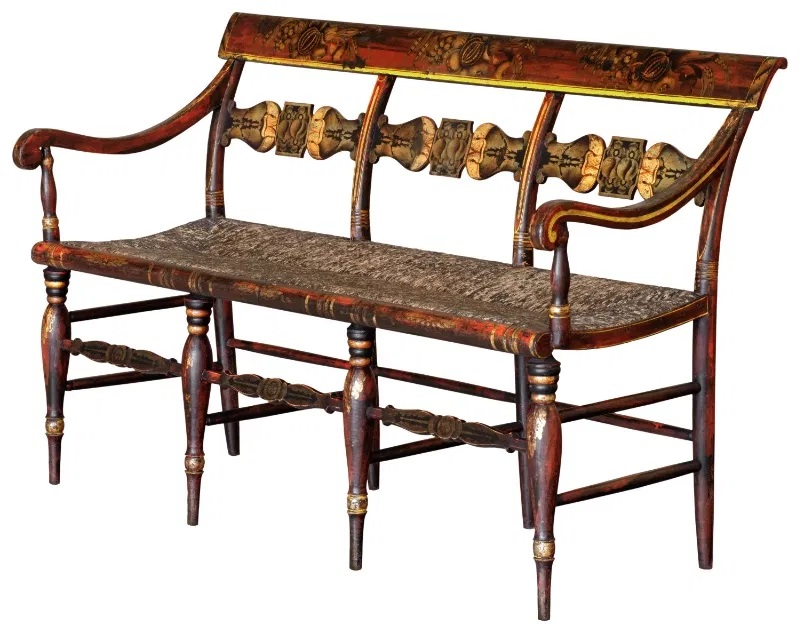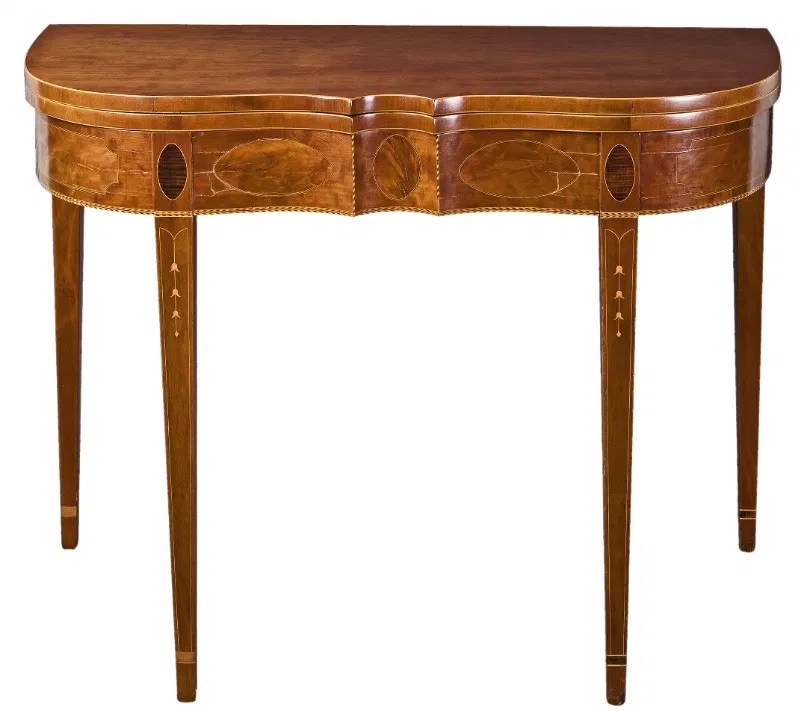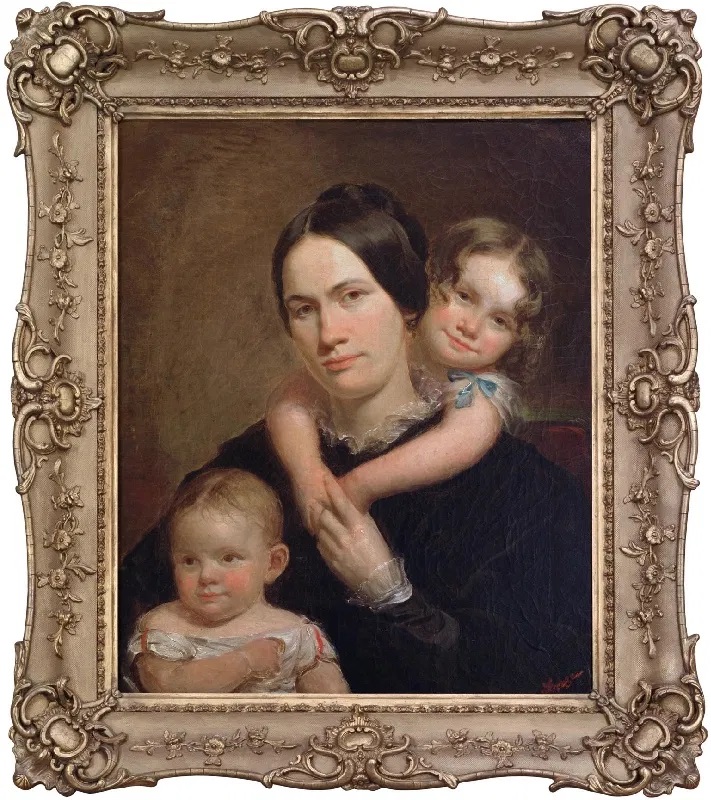Bluegrass Elegance: The Kentucky Collection of Sharon and Mack Cox
At the Decorative Arts Trust, visits to exclusive private collections add a special touch to our educational programs. With the postponement of the Spring 2020 Symposium in Lexington and Louisville, KY, in response to the COVID-19 pandemic, we realize that Trust members are missing these rare opportunities to see historic objects that are not accessible to the general public and to speak with the knowledgeable and dedicated collectors who graciously open their homes to our group.
Thankfully, Trust members Mack and Sharon Cox were kind enough to share some of their notable collection of Kentucky antiques with us, digitally! We hope you revel in this virtual tour of some exquisite items from the Coxes’ impressive holdings and appreciate their detailed descriptions.
Central Kentucky Clocks

Central Kentucky clocks. All images courtesy of the Cox Collection.
Kentucky enjoys an abundance of fine tall case clocks, which were expensive and reflect the wealth generated by fertile Bluegrass soils. Their small footprint allows collecting in numbers, as this group of nine clocks furnish our home today. It is a select assemblage. The original owners of seven clocks are known, eight are members of known Kentucky furniture groups, three can be attributed to a specific shop, and one is signed. They date from c. 1793 to 1833. Our collection includes most known Kentucky Rococo clocks (four), two transitional Rococo-Neoclassical clocks, and full-blown Neoclassical and Classical examples.
The assemblage says much about the development of Kentucky culture. Settlement began in 1775, and Kentucky received statehood in 1792. Most residents lived in forts until 1794, however, when hostilities with Native Americans abated. Thereafter, development of the wilderness happened at an unimaginable pace, and, by 1816, Lexington was known nationally as the Athens of the West. Throughout this period, residents were amazingly cosmopolitan. Few were born in Kentucky, and their origins included most regions of the early Republic as well as Europe and Africa. This diversity is reflected in Kentucky’s earliest furniture. For example, the second clock from the left might be mistaken for a Pennsylvania clock, or the third for a Rhode Island clock. The latter is attributed to Daniel Spencer (1741-1796), who migrated from Rhode Island to Kentucky in 1793, a maker explored in an essay in Chipstone’s American Furniture 2018.
With time, increasingly more Kentucky residents were natives resulting in the development of local furniture styles. A good example is the second clock from the right, which was made about 1820 by an unknown Lexington shop. It uses clock-on-frame construction where the case is attached with screws to a platform having turned legs and apron cutouts. Visually similar clocks were made by five or more different shops in the inner Bluegrass and the look is a distinctive part of central Kentucky’s cultural identity.
Portrait of James Clark Todd

Jacob Frymire, James Clark Todd, c. 1806, Lexington, KY. Oil on canvas, 50 ½” x 32 ½”.
This portrait of James Clark Todd (1802?–1849) is among the earliest extant Kentucky paintings. It is attributed to Jacob Frymire (1765?–1822) who worked in Pennsylvania, Maryland, and Virginia, but visited Kentucky in 1806 where a handful of his works are known. The subject’s father was Levi Todd (1756–1807), who migrated to Kentucky in 1775 and was among Lexington’s founders. Levi was a contemporary of Daniel Boone, and both led at Blue Licks, a 1782 Revolutionary War battle that occurred in Kentucky (when it was still part of Virginia).
In 1787, Levi Todd built Lexington’s first brick home where his son’s portrait was taken in 1806. James Clark Todd is stylishly dressed, holds a hat in his left hand, and leans on a small table draped with a red cloth. The table has turned legs with scrolled stretchers and a finial. It is similar in form to Baltimore tables of this era and painted brown with a spiral stripping down each leg. Most notable is the fine carpet that was likely imported from Baltimore or Philadelphia. It would have been hauled over the Appalachian Mountains to Pittsburgh, floated 500 miles down the Ohio River, and lastly brought by wagon from Maysville to Lexington. Prior to the arrival of steamboats, carpet was rare and exceedingly costly in Kentucky.
The subject’s niece (Mary) wed Abraham Lincoln in 1842 and was first lady of the United States from 1861 to 1865. Her cousin, Dr. Lyman Beecher Todd, the sitter’s son and second owner of this painting, was among the attending physicians after Lincoln’s assassination.
Fancy Settee

Fancy Settee, c. 1825, Lexington or Frankfort, KY. H: 33 ½”, W: 54 ½”, D: 22 ½”.
This diminutive fancy settee was owned by Dr. Nicholas Warfield (1786–1863) who lived near Lexington, KY. It was one of a pair, along with a set of similar dining chairs that descended in Warfield’s family until the 1960s. The settee retains its original vermillion red paint, with chromium yellow and gold leaf accents. On the crest rail are still-life paintings of squash, grapes, pears, and wheat, and the shaped medial slats are decorated with stenciled floral designs.
The settee is part of an emerging Kentucky shop group that includes a side chair (Cox collection) having the same form, but with a different paint scheme, and another fine settee with similar legs that has always furnished Liberty Hall (1802) in Frankfort, KY. The shop, which was likely located in Lexington, was apparently influenced by designs emanating from Philadelphia or Baltimore, where similar forms and leg turnings occur.
Porter Clay Sideboard and Games Table

Porter Clay, Sideboard, c. 1805, Lexington, KY. H: 42”, W: 71”, D: 23 ½”.

Porter Clay, Games Table, c. 1805, Lexington, KY. H: 29 ½”, W: 36 ¼”, D: 17 ¾”.
In 1806, Thomas Ashe of England described Lexington as having over 300 mostly brick homes, many “furnished with some pretensions to European elegance” (Travels in America, London, 1808, p. 192). This sideboard was made in Lexington about that time and is attributed to Porter Clay, a brother of Henry Clay (1777–1852), the well-known 19th-century politician from Lexington. Porter migrated from Virginia to Kentucky with his parents in 1792 and was bound to Thomas Whitney, an Irish cabinetmaker who worked in Lexington. In 1798, he ran away to New York City and worked as a journeyman. Porter returned the following year and opened a Lexington cabinetshop where he made furniture until 1808. His furniture exhibits New York and Philadelphia influence and borrows designs in Thomas Sheraton’s 1802 Drawing-Book. Afterwards, Porter became an attorney, Kentucky State auditor, and lastly a traveling Baptist preacher.
A great example of high-style, Kentucky urban furniture, this sideboard has a cove-shaped center flanked by serpentine shaped drawers and tambour doors and rounded ends. It is made of cherry and crotch cherry and walnut veneers with oak and poplar secondary wood. Walnut panels outlined with stringing are let into the outer face of each leg and a banding of tiger maple defined by light and dark string run the lower perimeter of the case. One tambour door retains an early backing, which is block-printed French wallpaper. Four similarly shaped sideboards are known, all with cove-shape centers. Porter incorporated a similar cove-shape in most of his games tables. The cove-shape is unusual and considered a trait of Porter Clay.
Mitchell Family Portraits

Matthew Harris Jouett, Martha Bell Mitchell and Alexander John Mitchell, Jr., c. 1826, Lexington, KY.

Oliver Frazer, Martha Bell Mitchell, c. 1849, Lexington, KY.

Matthew Harris Jouett, Jouett Home & Home Studio, Lexington, KY, c. 1818, Lexington, KY.
Lexington was Kentucky’s economic and artistic center prior to the steamboat era (c. 1820). Matthew Harris Jouett (1788–1827) was Kentucky’s foremost Antebellum artist of that time, succeeded by Oliver Frazer (1808–1864), the most celebrated of his generation. They were related through Jouett’s wife, Peggy Allen (1795–1873), who had two sisters. Elizabeth Allen (c. 1792–1840) wed Dr. A. J. Mitchell, and their daughter, Martha Bell Mitchell (1816–1903), grew up to wed Oliver Frazer. Jouett painted Martha and her brother (his niece and nephew) in 1826, but died before its completion (first image). She was painted again in 1849 by Oliver Frazer (her husband) along with two of their children (second image).
Jouett and Frazer lived on small adjoining farms just north of Lexington with their homes about 1,000 feet apart. Frazer bought his home from Jouett’s other sister-in-law, Rebecca Allen Redd (1803–1866). Jouett painted all three Allen sisters and gave a landscape painting of his home (third image) to Rebecca Allen painted about 1818. Jouett had two studios, one in Lexington and one at his home, which was in the ell projecting from the left side of his home in the painting. It was a large room, open to the rafters with a dormer and large windows for lighting.
Kentucky Penitentiary Armchair

Armchair, c. 1820, Kentucky Penitentiary, Frankfort, KY. H: 38 3/8”, W: 23 ¼”, D: 22 ¼”.
We call this a “non-electric chair of redemption.” The Kentucky Penitentiary in Frankfort opened in 1800, and from 1804 to 1928 used convict labor to produce shoes, barrels, nails, shingles, cut stone, chairs, and other products that were sold to defray incarceration costs. This elegant form, with continuous arms, was made from about 1810 to 1840, with examples transitioning from the Neoclassical through Classical styles. The design is northern Italian, where the form dates to a generation earlier but with variants continuing from the late 18th century to the present. How the design came to Kentucky remains a mystery.
The Decorative Arts Trust thanks the Coxes for sharing treasures from their private collection with us. We hope to take our members to see these objects in person soon!
For updates on Trust programs, check our website, sign up for our e-mail list, or follow us on social media. During this challenging time, the Trust continues to promote and foster the appreciation and study of the decorative arts through digital resources and support of emerging scholars through grants and scholarships. Consider becoming a member or donating an unrestricted gift to help us achieve our mission.
About The Decorative Arts Trust Bulletin
Formerly known as the "blog,” the Bulletin features new research and scholarship, travelogues, book reviews, and museum and gallery exhibitions. The Bulletin complements The Magazine of the Decorative Arts Trust, our biannual members publication.







